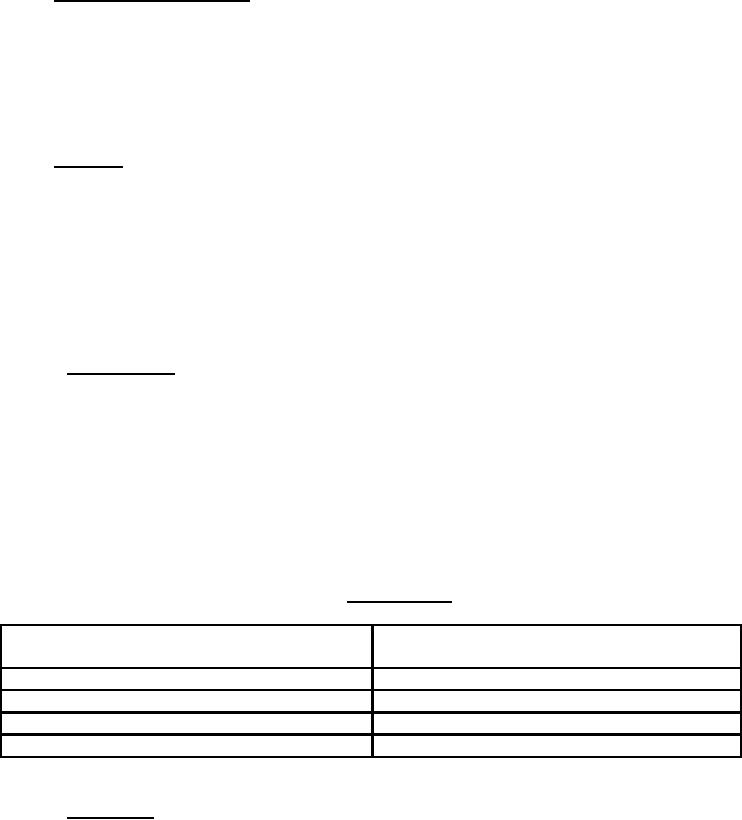
MIL-PRF-26611F
applied between pins A, B, and C, in turn, and the metal parts of the generator case (including
the receptacle shell) for 5 seconds. There shall be no insulation breakdown as indicated by
leakage current in excess of 0.002 amp.
4.6.6 Low temperature operation. The generator shall be placed in a temperature chamber set to
-85° ± 10°F for a minimum of 44 hours without rotating the drive shaft. After 44 hours, still
at -85° ± 10°F, the shaft shall be rotated at 25 ± 5 rpm for 15 ± 1 minutes. The chamber
temperature then shall be raised to -50° ± 10°F and maintained for a minimum of 20 hours
without rotating the drive shaft. After 20 hours at -50° ± 10°F, the drive shaft shall be rotated at
25 ± 5 rpm. The breakaway torque shall not exceed 8 inch-pounds and the torque required to turn
the shaft within the first minute of rotation shall not exceed 1.5 inch-pounds.
4.6.7 Vibration. Prior to vibration, the output voltage shall be measured in accordance with
4.6.4. The generator shall be mounted without vibration isolators directly to the vibration exciter.
Tests shall be conducted under both resonance and cycling conditions as specified in paragraphs
4.6.7.1 and 4.6.7.2. Time consumed performing 4.6.7.1 plus time consumed cycling in 4.6.7.2
shall equal 3 hours. Vibration displacement, velocity, and acceleration shall be measured at the
specific instantaneous test frequency applied. Loose components that impact each other resulting
in a high "noise" content of the applied vibration shall be considered as vibration input. If such
"noise" is encountered, a low pass frequency filter that cuts off at approximately twice the test
frequency shall be employed to reject the "noise."
4.6.7.1 Resonance test. Resonant nodes of the generator shall be determined by varying the
frequency of applied vibration slowly through the specified range at vibrator accelerations shown
in Table II. Individual resonant nodes surveys shall be conducted with vibration applied along
each set of three mutually perpendicular axes of the generator. The generator shall be vibrated at
the indicated resonant conditions for the times shown in Table III and the applied double
amplitudes of vibrator accelerations in Table II. Vibration shall be applied along each of the
three mutually perpendicular axes. If more than one resonance is encountered when vibration is
applied along any one axis, each resonance shall be sustained for the time shown in the
applicable portion of the vibration test schedule. If more than four resonances are encountered
with vibration applied along one axis, the four most severe resonances shall be chosen for test.
TABLE II. Vibration data.
Frequency (Hz)
Displacement in double amplitude (inch)
and Acceleration (g), if applicable
5 - 14
0.1
14 - 23
0.1 to 0.036 at 20g
23 - 104
0.036
104 - 2,000
0.036 to 0.001 at 20g
4.6.7.2 Cycling test. The generator shall be connected to the standard load and the drive shaft
rotated at 4,450 ± 250 rpm. While operating, the generator shall be vibrated in accordance with
the vibration schedule in Table III. The frequency shall be varied logarithmically from 5 to 2,000
6
For Parts Inquires call Parts Hangar, Inc (727) 493-0744
© Copyright 2015 Integrated Publishing, Inc.
A Service Disabled Veteran Owned Small Business